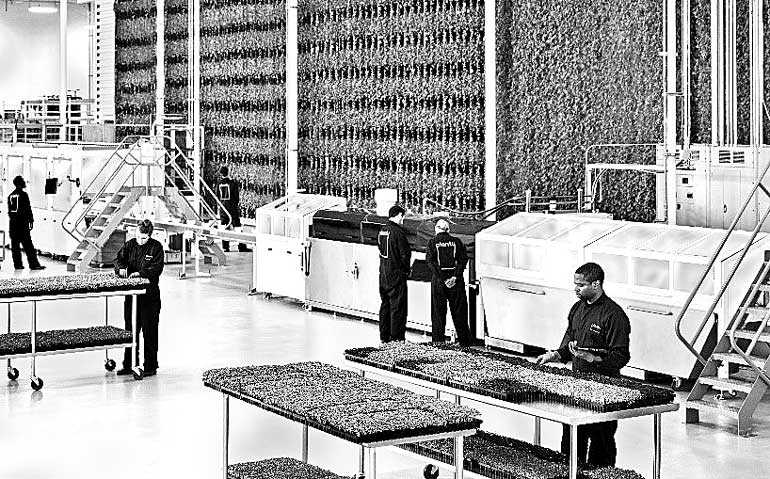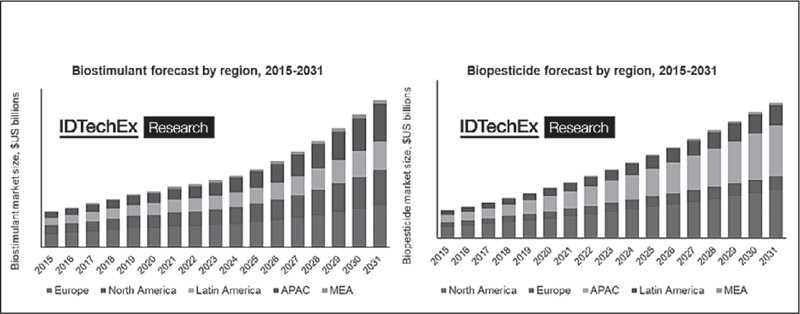Sunday Apr 20, 2025
Sunday Apr 20, 2025
Tuesday, 15 December 2020 00:01 - - {{hitsCtrl.values.hits}}

Vertical farming could enable highly efficient crop production, disrupting food supply chains (Image source: Plenty)
|
Supply chain instabilities alongside increasing skepticism around the meat industry lead to sales of plant-based meat alternatives booming in 2020
|
YEAR 2020 has been a challenging year for the food and agriculture industries, with COVID-19 having impacted the entire food supply chain from field to consumer.
Restrictions of movement for workers, closures of food production facilities, and unpredictable changes in consumer demand highlighted instability and inflexibility in the food supply chain, creating severe challenges for farms, businesses, and consumers alike.
The pandemic also put the spotlight on the global meat industry and its role in zoonotic disease outbreaks, with COVID-19 being the latest in a range of outbreaks linked with the meat industry including several aviation flu outbreaks and the earlier SARS epidemic that hit China in 2002.
However, the crisis caused by the COVID-19 outbreak has led to several opportunities in the global food and agriculture industry, particularly for alternative and novel food systems.
An industry that has seen a particular surge in interest is vertical farming. Vertical farming involves growing crops indoors in stacked layers under a controlled environment, enabling year-round highly efficient crop production in almost any location, including in the middle of cities.
By enabling rapid, local production, vertical farming can reduce the miles that food must travel before it reaches consumers and enable production to be increased to reflect local changes in demand. Vertical farms could be set up in or around supermarket distribution centres, delivering large quantities of fresh produce to consumers within a day of harvest, circumventing the supply chain issues that were exposed during the worst of the pandemic.
Recognising this potential, investors have poured money into vertical farming in 2020, with US company Plenty raising $ 140 million in Series D funding in October and Berlin-based InFarm raising $ 170 million in Series C funding just a few weeks earlier. However, despite the advantages and money raised by vertical farming, there are challenges.
Many start-ups have struggled with running costs and high up-front costs that can lead to a difficult trade-off between expensive automated equipment that save money later and cheaper, more manual equipment that can lead to high operational costs. The recent IDTechEx report ‘Vertical Farming 2020-2030’ explores the key technological and market factors that could lead to the success or failure of the vertical farming industry.
Another alternative food system that has benefitted from the pandemic is the alternative proteins space. Closures of meatpacking facilities in the immediate aftermath of the COVID-19 outbreak alongside growing consumer scepticism of the meat industry led to a surge in sales of plant-based meat alternatives, with Nielsen reporting that US sales of alternative meat products rose by 264% in the nine weeks ending on 2 May.
Alternative proteins industry body The Good Food Institute reported that $ 930 million was invested into the alternative proteins space in the first quarter of 2020, more than the amount raised in the entire of 2019.
According to the IDTechEx report covering this space ‘Plant-Based and Cultured Meat 2020-2030’, this trend is set to continue, with the market for novel meat substitutes expected to exceed $ 30 billion by 2030.
As this market grows, it will create significant opportunities for companies throughout the value chain, including protein providers, hardware manufacturers and chemical companies, particularly as technological advances lead the field in new directions, such as meat products created from cultured animal cells and proteins derived from novel fermentation techniques.
Outside of the COVID-19 pandemic, there are growing opportunities in the food and agriculture space. In 2020, the European Commission, the executive branch of the European Union, announced a ‘Green Deal’ farming plan to reduce synthetic pesticide use by 50% and reduce synthetic fertiliser usage by 20%. The recent election of Joe Biden in the US suggests that America is also likely to increase its focus on sustainability over the coming years.
An area of agricultural technology that could benefit from this is the industry for agricultural biologicals. Agricultural biologicals is an umbrella term for crop protection and enhancement tools derived from nature, including biostimulants, biopesticides, and biofertilisers.
Unlike conventional agrochemicals, which tend to be based on small molecules and chemicals derived from mineral sources, agricultural biologicals cover a wide range of products, such as plant extracts, insect pheromones and genetically engineered bacteria that manipulate the microbiome of crops.
Agricultural biologicals are growing quickly. Over the last decade, the market has expanded by 500%, 10 times the rate of growth of the chemical pesticides market.
The drive towards sustainability in agriculture is a big reason behind this growth. As they are derived from nature, there are hopes that biologicals will have less of an adverse environmental impact than crop protection chemicals. Biological methods of crop protection such as predatory insects or bacteria that produce insecticidal compounds could also help reduce the amounts of synthetic chemicals that need to be sprayed on fields.
Additionally, the production of biologicals derived from plants and bacteria is likely to have a smaller carbon footprint than the synthesis of agricultural chemicals. These sustainability benefits are coupled with a serious need for innovation in agrochemicals. Growing pesticide resistance and increasingly harsh regulations around agrochemicals are leaving farmers with fewer tools to protect their crops and boost their yields. Agricultural biologicals could help to change this.
The IDTechEx report ‘Biostimulants and Biopesticide 2021-2031’ provides a technical overview of the emerging space around agricultural biologicals, evaluating the opportunities and challenges facing the industry and forecasting the market size over the next decade, predicting that the market for agricultural biologicals will reach $ 19.5 billion by 2031.
As food production continues to evolve in 2021 and beyond, synthetic biology, genome editing, and other genetic technologies will play an increasingly important role in agriculture. Genome editing technologies such as CRISPR and TALENs have been a particular source of excitement, potentially allowing for precise and low-cost modifications of the genome for crop improvement.
Although 2020 was a quiet year for these technologies in agriculture, it saw extended rollout of Calyxt’s Calyno brand high oleic soybean oil, the first commercial application of genome editing in agriculture. In March 2020, over 100,000 acres of cropland in the US had been planted with Calyno soybeans, with Calyxt expecting to have over 25% market share of H0 soybean acres by the end of 2020.
Genetic technologies in agriculture will also help to support advances across the AgTech industry. Californian start-up Pivot Bio is using genetic engineering to create nitrogen-fixing microbial crop treatments and Bayer joint venture Joyn Bio is developing synthetic biology techniques to create similar biostimulants.
Genetic technologies may even find increasing application in the alternative proteins space. Biodesign company Geltor uses synthetic biology to create designer proteins for the beauty and nutrition industries, while cultured meat companies such as Memphis Meats are investigating the use of genome mapping and modifying tools to help create realistic meat products from cultured animal cells.
‘Genetic Technologies in Agriculture 2020-2030’, a new report from IDTechEx, provides a technical overview of the range of genetic tools used in agriculture and provides an outlook for the next 10 years in the industry.
Despite the challenges seen in 2020, the outlook for AgTech is bright, with numerous opportunities for innovative companies in the space. IDTechEx has a portfolio of reports and research into Food and AgTech, proving clarity and guidance into several emerging technologies within the space.

IDTechEx predicts strong market growth for the biostimulant and biopesticides industries. Image source: IDTechEx ‘Biostimulants and Biopesticides 2021-2031’
Discover Kapruka, the leading online shopping platform in Sri Lanka, where you can conveniently send Gifts and Flowers to your loved ones for any event including Valentine ’s Day. Explore a wide range of popular Shopping Categories on Kapruka, including Toys, Groceries, Electronics, Birthday Cakes, Fruits, Chocolates, Flower Bouquets, Clothing, Watches, Lingerie, Gift Sets and Jewellery. Also if you’re interested in selling with Kapruka, Partner Central by Kapruka is the best solution to start with. Moreover, through Kapruka Global Shop, you can also enjoy the convenience of purchasing products from renowned platforms like Amazon and eBay and have them delivered to Sri Lanka.
Discover Kapruka, the leading online shopping platform in Sri Lanka, where you can conveniently send Gifts and Flowers to your loved ones for any event including Valentine ’s Day. Explore a wide range of popular Shopping Categories on Kapruka, including Toys, Groceries, Electronics, Birthday Cakes, Fruits, Chocolates, Flower Bouquets, Clothing, Watches, Lingerie, Gift Sets and Jewellery. Also if you’re interested in selling with Kapruka, Partner Central by Kapruka is the best solution to start with. Moreover, through Kapruka Global Shop, you can also enjoy the convenience of purchasing products from renowned platforms like Amazon and eBay and have them delivered to Sri Lanka.